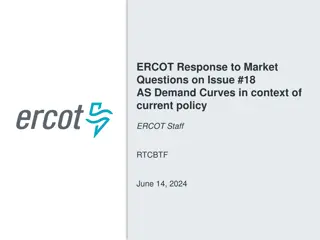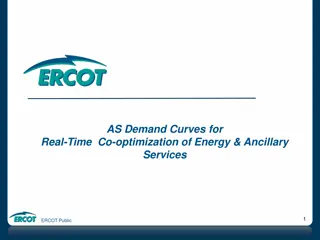
Revisiting the Operating Reserve Demand Curve Analysis
Explore the analysis of the Operating Reserve Demand Curve (ORDC) and its impact on the energy market. Review the market behavior, adjustments for new reliability standards, and expected outcomes for market participants. Understand the implications of the ORDC implementation and lessons learned from past data.
Download Presentation

Please find below an Image/Link to download the presentation.
The content on the website is provided AS IS for your information and personal use only. It may not be sold, licensed, or shared on other websites without obtaining consent from the author. If you encounter any issues during the download, it is possible that the publisher has removed the file from their server.
You are allowed to download the files provided on this website for personal or commercial use, subject to the condition that they are used lawfully. All files are the property of their respective owners.
The content on the website is provided AS IS for your information and personal use only. It may not be sold, licensed, or shared on other websites without obtaining consent from the author.
E N D
Presentation Transcript
Revisiting the Operating Reserve Demand Curve Randy Jones November 13, 2015
ORDC: Time for Review PUCT directed ERCOT and stakeholders to review the market impact of the ORDC Actual market data is available for review, market participants have ~16- months experience with the ORDC, including two summer peak seasons (2014 and 2015) NERC adopted new reliability standard, BAL-003-01; ORDC change needed to be consistent with new standard ORDC is intended to and should reflect ERCOT s willingness to pay for reserves current design is not consistent with new NERC requirements, e.g. application in DAM could result in under-procurement of RUS and/or RRS 2
ORDC: Set X to Reflect New NERC Reliability Standard Adjust Minimum Contingency Limit ( X ) to reflect new NERC reliability standard, BAL-003-01 Set X equal to the Responsive Reserve Service ( RRS ) and Regulations Up Service ( RUS ) reliability requirements In the Real-time Co-Optimization development in ERCOT, demand curves for RRS and RUS would both be set at SWOC Setting X equal to RRS + RUS requirements makes ORDC consistent with concept ORDC is designed to mimic RTC RRS requirment is based on protecting the grid against loss of the two largest units (2750MW) in ERCOT; to be conservative, set X equal to RUS plus the greater of RRS requirement or 2750 MW 3
ORDC: Market Participant Behavior Impacts Expected Results Assume ORDC implemented in 2012 (most similar to June 2014-May 2015 weather) Using ERCOT backcast for 2012 : ERCOT's backcast spreadsheet with VOLL = $9,000/MWh and X = 2,000MW results in PNM estimate of $87,174/MW-year Actual PNM for 2012 was $33,952/MW-year, <40% of ERCOT backcast In contrast, actual PNM was just under $29,000/MW-year for similar ORDC year of June 2014-May 2015 Post-ORDC implementation results indicate a slight reduction in PNM compared to ERCOT backcast estimate more than double actual 2012 PNM Takeaway: More realistic views of adder results require backcast scenarios to reflect market participant behavior; avoid significant overestimates of various proposals Note: ERCOT backcast for 2012 is based on piecewise linear curve. Using actual LOLP curve would decrease ERCOT s backcast for 2012 to roughly $60,000/MW-year. 4
Summary Calpine s proposal is in direct response to the Commissioner Anderson s request to review The level of X used in the ORDC formula, which is 2,000 MW of operating reserves . Set X to reflect reliability standards, i.e. set X equal to RRS plus RUS reliability requirements Resetting X has the most immediate and significant impact on signals sent to loads and resources as the system approaches scarcity conditions A change in X does not require a rule change and can be done without much complexity 5






















